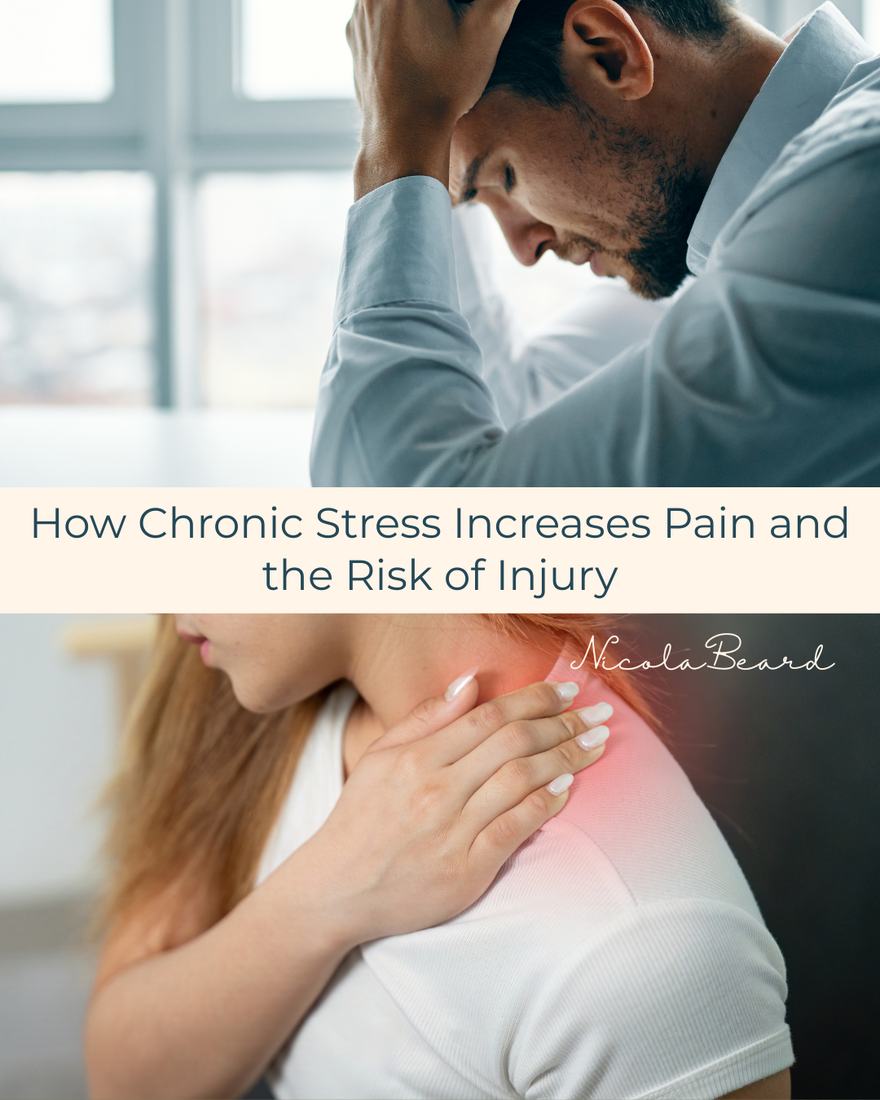
Understanding how tension, posture and nervous system imbalance set the stage for pain and breakdown
Stress is not only a mental experience but a full-body state that changes breathing patterns, muscle tone and joint alignment, influencing the way we move and the way we feel. When the nervous system stays alert for too long, these changes become part of how the body organises itself. Muscles begin to hold tension automatically, posture adapts to that tension, and the body gradually learns to live in a protective state that was never designed to last.
Through my years teaching Pilates, corrective movement and now Shibashi, I have seen the same patterns appear again and again. Many people arrive with back pain, shoulder discomfort or restricted shoulder movement. They often do not realise that these problems are linked to posture, breathing and the way the body responds to stress.
They usually describe feeling tired, stiff or on edge, believing it is simply part of getting older or living a busy life. What I see is a body that has been working too hard for too long, with a nervous system that has forgotten how to switch off.
When the Body Stays in Defence Mode
When the brain senses threat, it activates the sympathetic nervous system to prepare the body for action. Heart rate increases, breathing becomes faster, and stress hormones such as adrenaline and cortisol flood the bloodstream. This system is designed for short-term protection, but when modern life keeps triggering it, the body never receives the message that the danger has passed.
Muscles that should tighten briefly begin to hold tension as their default setting. The shoulders lift, the jaw clenches, the breath becomes shallow and the spine compresses. These are not random aches or poor habits but physiological signs of the body staying ready for action. Research has shown that when cortisol remains high for long periods, it increases inflammation, slows tissue repair and heightens pain sensitivity (McEwen, 2016; Bair et al., 2014). Long-term stress also interferes with muscle recovery and reduces the body’s ability to maintain healthy tone (Juster, McEwen and Lupien, 2010).
How Stress Builds Tension, Pain and Injury
Long-term stress changes how the musculoskeletal system behaves. The small muscles of the neck stay tight to keep the head alert, often causing headaches and limiting movement. The chest muscles shorten while the upper back weakens, pulling the shoulders forward and restricting the breath. The deep stabilisers of the spine lose coordination and the surface muscles take over. It gives the appearance of strength but is actually bracing.
Further down, the hip flexors tighten and tilt the pelvis forward, increasing the curve in the lower spine, compressing the lower back and limiting natural hip extension. Shortening the length of each stride increases the risk of what many call the “senior shuffle.” Balance becomes unstable and movement starts to feel effortful rather than fluid. This posture may feel familiar or even necessary, but it places the body under constant strain and reduces the ability to adapt to load or movement.
When muscles are already tight and fatigued, the risk of injury increases. Tissue that lacks elasticity cannot absorb shock, so when extra stress is added through lifting, twisting or even moving quickly, the fibres may tear.
Most injuries of this kind do not happen suddenly, although they may appear to occur out of the blue during everyday activities such as putting on a sock, bending to pick up a pen or reaching for a seat belt. They develop gradually as tension, restricted movement and limited recovery accumulate over time (Allen and Proske, 2025). Studies also show that even short periods of poor posture can lead to measurable fatigue in spinal muscles (Sun et al., 2020).
The Foundation Beneath It All
Everything we do begins …From The Feet Up.
Years of wearing cushioned, rigid or elevated-heeled shoes reduce the natural strength and sensory awareness of the feet and shift the body’s weight forward, altering posture throughout the kinetic chain. Even a small heel changes the angle of the ankle, shortens the calf muscles, tilts the pelvis and increases compression in the lower back, leading to knee pain, recurring ankle injuries, and lower back pain, to name just a few issues.
Over time, this imbalance contributes to common issues such as plantar fasciitis, bunions, tight hips and persistent lower back pain. When the feet lose their ability to feel, stabilise and absorb load, the larger muscles of the legs, hips and spine are forced to compensate, creating the same kind of chronic tension we often associate with stress.
The result is a gradual chain reaction where fatigue, stiffness and pain travel upward through the body.
From my earlier work as a foot pain and movement specialist, I saw how rebuilding awareness and strength at ground level could transform posture and balance.
Shibashi continues that principle.
Practising barefoot (when it’s warm enough) reawakens the feet’s sensory feedback and grounding reflexes, helping posture to steady and the body to move with greater efficiency and ease. When the foundation is balanced, everything above it begins to find its place again.
The Cycle That Keeps Stress Alive
Once these patterns become established, they begin to sustain themselves. Tense muscles continuously send feedback to the brain, confirming the feeling that something is wrong. The brain responds by releasing more stress hormones, which increase tension even further. Over time, physical tightness and emotional stress merge into one experience. The body remains alert even when the situation no longer calls for it.
Research now recognises that pain and stress share a single feedback system. Each can trigger the other, creating a continuous cycle that affects both body and mind (Schmidt, Dunbar and Vidal, 2024). To break this cycle, the nervous system must receive physical evidence that it is safe. Logical reasoning does not achieve this. The change has to be felt through movement, breathing and rhythm.
How Shibashi Helps the Body Reset
Tai Chi Qigong Shibashi offers a practical way to send that message of safety through the body. The slow, rhythmic movements combine with steady nasal breathing to retrain the nervous system to associate calm with motion.
Breathing through the nose warms and filters the air, balances oxygen and carbon dioxide and allows the diaphragm to move freely. This movement of the diaphragm stimulates the vagus nerve, which helps reduce muscle tone and calm the body’s stress response.
Research supports what many people experience in practice. Gentle breathing techniques reduce perceived stress and muscle tension and improve the body’s ability to recover from strain (Zaccaro et al., 2023). In Shibashi, each repeated motion helps the body find rhythm and coordination again.
Weight shifts through the feet restore grounding and awareness of balance, while the sweeping of the arms opens the chest and releases tension from the upper body. In terms of corrective movement, this improves alignment and joint control.
In Traditional Chinese Medicine, it allows qi to circulate freely through the meridians that support energy balance and emotional stability. Both explanations describe the same process of restoring flow where it has been lost.
When the Body Finds Its Balance Again
As the body begins to let go of tension, posture reorganises naturally. Shoulders align more easily with the ribcage, breathing deepens and the spine regains its natural length. People often describe a feeling of lightness or ease after class, which reflects a real shift in muscle tone and awareness rather than imagination.
This is not passive relaxation but active regulation, where the body’s systems return to their normal range between alertness and recovery.
When this happens, effort reduces because less energy is spent on unnecessary holding. Circulation improves, joints move more freely and coordination returns. The body begins to feel supported again from the ground up, and the mind responds with the same sense of steadiness.
A Simple Way to Begin
Stand with your feet hip-width apart and breathe through your nose. Let the ribs expand gently in all directions, then exhale slowly and allow the shoulders and jaw to release. Feel the weight spread evenly through both feet and notice how your body starts to settle. This moment of awareness is the same principle that a full Shibashi session builds upon.
The Bigger Picture
Chronic stress changes the way muscles behave, the way posture develops and the way movement feels. Over time, the body adapts to a state of readiness that gradually leads to fatigue, stiffness and pain. The solution is not to force relaxation but to teach the body how to balance effort and ease again. Movement, breath and awareness together provide that learning.
Shibashi offers a structure that supports this process. It combines the precision of corrective movement with the mindfulness of Qigong, helping the body stay adaptable and steady. Regular practice prevents tension from accumulating to the point where it becomes pain or injury.
Each session teaches the nervous system that it can return to calm through movement rather than collapse, which is the essence of prevention in both physical and energetic terms.
If you would like to experience this for yourself, you can join me for a Shibashi class or start with Press Pause. Through gentle, consistent practice, the body learns to recognise safety again and returns to its natural rhythm of strength and ease.
Press Pause - 10 Minutes to Unwind Your Mind
References
Allen, J. and Proske, U. (2025) ‘Overlaps of skeletal muscle fatigue and damage: implications for injury risk’, Sports Medicine – Open, 11 (2), pp. 45–57. doi: 10.1186/s40798-025-00876-z
Bair, M. J., Wu, J., Damush, T. M., Sutherland, J. M. and Kroenke, K. (2014) ‘Chronic stress, cortisol dysfunction and pain’, Psychoneuroendocrinology, 47, pp. 95–107.
Juster, R.-P., McEwen, B. S. and Lupien, S. J. (2010) ‘Allostatic load biomarkers of chronic stress and impact on health’, Neuroscience and Biobehavioral Reviews, 35 (1), pp. 2–16.
McEwen, B. S. (2016) ‘The effects of chronic stress on health: insights into the stress response’, Molecular Psychiatry, 21 (8), pp. 1058–1070.
Schmidt, R. M., Dunbar, J. and Vidal, P. (2024) ‘The mutually reinforcing dynamics between pain and stress’, Frontiers in Pain Research, 5, 1445280. doi: 10.3389/fpain.2024.1445280
Sun, Y., Liu, J., Kong, J. and Yao, W. (2020) ‘Effective assessments of a short-duration poor posture and its impact on muscle fatigue’, Frontiers in Physiology, 11, 541974. doi: 10.3389/fphys.2020.541974
Zaccaro, A., Palmieri, L., Piarulli, A. and Laurino, M. (2023) ‘Acute effects of breathing exercises on muscle tension and psychological stress’, Frontiers in Psychology, 14, 1155134. doi: 10.3389/fpsyg.2023.1155134
